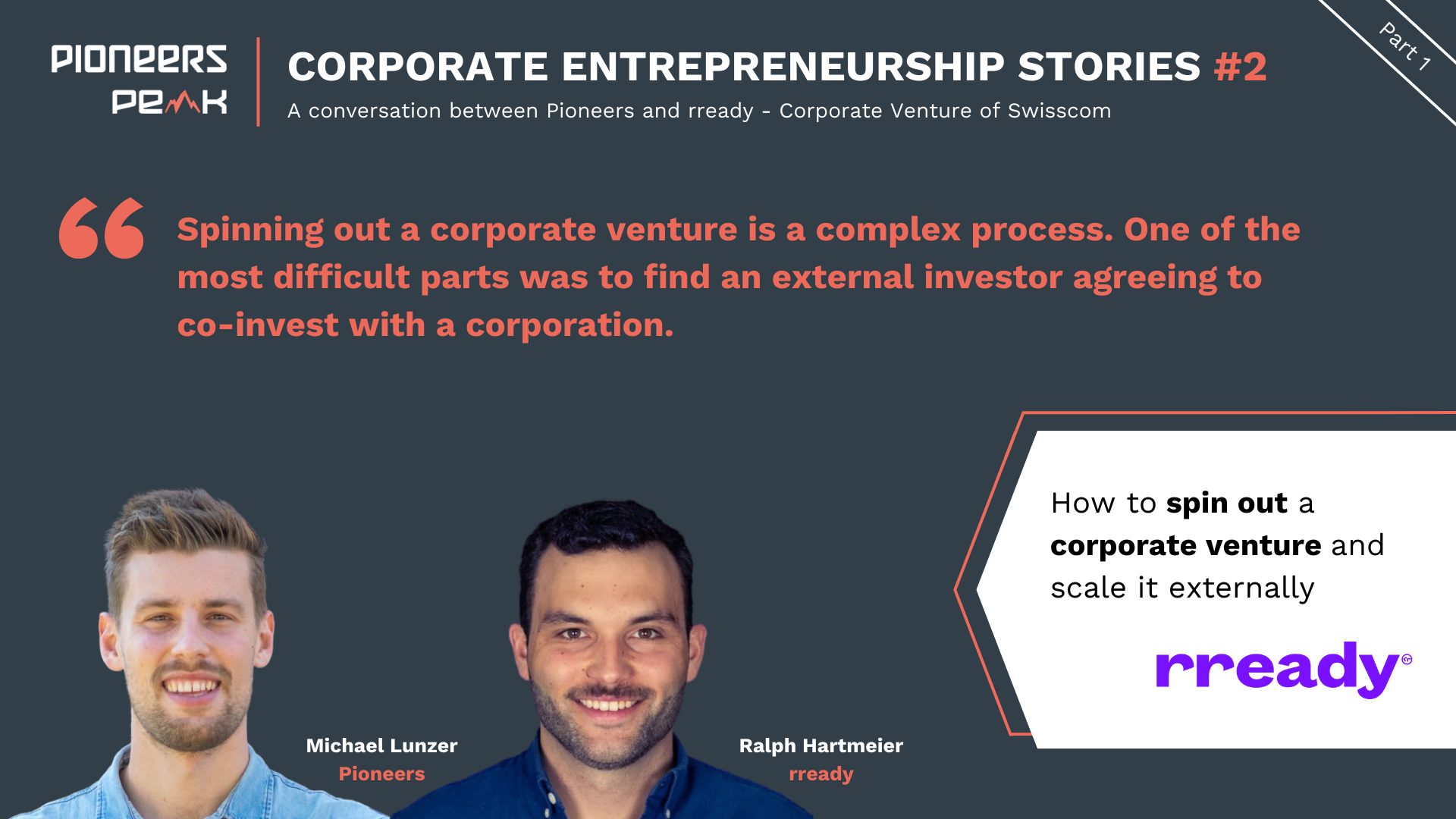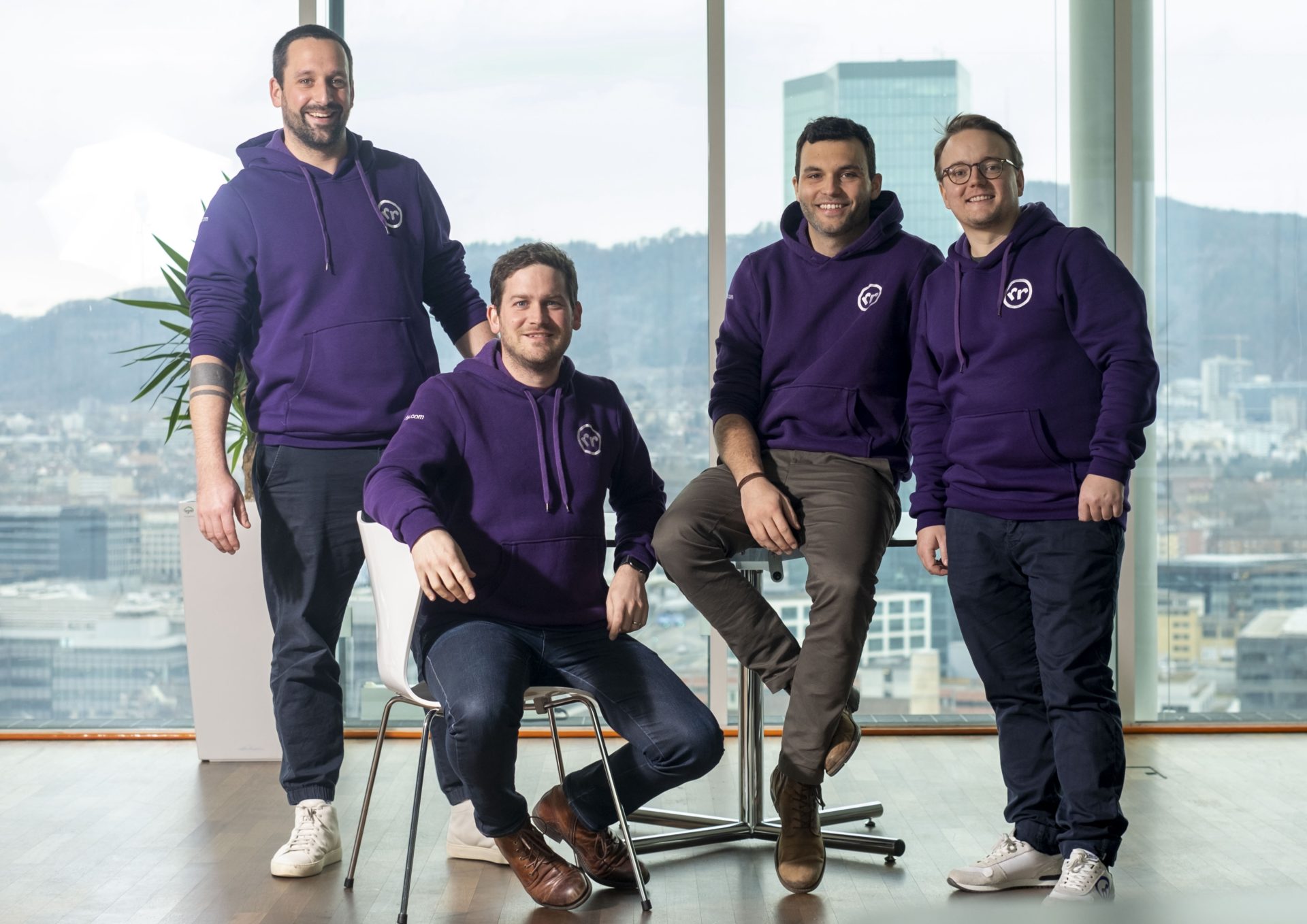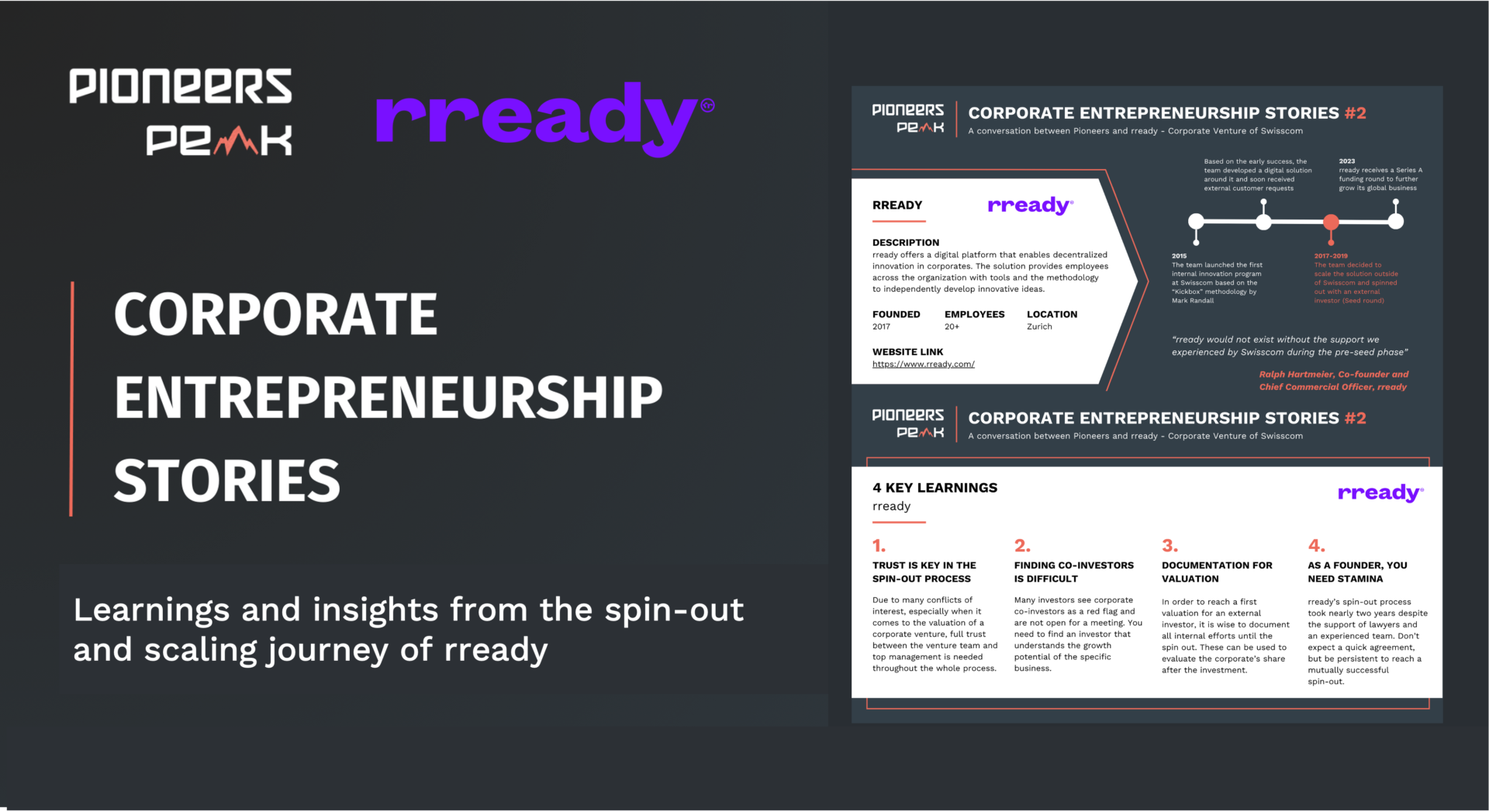
Corporate Entrepreneurship Stories #2 – rready – Part 1
Part 1 – rready’s early phase, the difficult spin-out process, and relationship with the mother company – Swisscom.
In this episode, we take a closer look at rready, a corporate venture of Swisscom. Michael Lunzer, Head of Venture Design at Pioneers had an insightful conversation with rready’s co-founder and Chief Commercial Officer Ralph Hartmeier.
Ralph’s entrepreneurial journey started at the university when he founded his first startup – sports and fitness platform. Finishing his studies he joined Swisscom’s innovation team, where he was in charge of fostering internal innovation together with his colleagues. After some time, they came across the “Kickbox” methodology invented by Mark Randall.
Compared to other approaches, Kickbox supports employees to validate their business ideas by sending them boxes of support materials. These provide instructions and guidelines on how to validate the customer, build prototypes, draw up a business case, and many more. Along the process, and by passing various gates, employees get larger boxes with more extensive materials and coaching support.
Fascinated by this approach, Ralph and his team launched a Kickbox program at Swisscom. Based on the program’s early success, the team expanded the approach and developed a digital layer around it. Sharing about their success at different events, they soon received requests from other companies to use their digital solution.
That was the moment when the team realized the solution’s potential to become its own business. Today, rready has a team of 20+ employees and a client base of over 40 international clients using the digital platform. In our conversation, we dive deeper into the entrepreneurial journey of Ralph and his team.
In part #1 we look at the early developments of the venture, the difficult spin-out process as well as the relationship with the mother company.
Michael Lunzer, Pioneers:
Ralph, nice to meet you again and learn more about the full story of rready. To start, tell us more about your current solution and traction on the market.
Ralph Hartmeier:
Nice to meet you as well. Sure, since our last encounter, we have developed our solution quite a bit. As of now, we offer two solutions at rready.
As our core solution, we still offer the digital employee activation tool [Kickbox]. Through the platform, we enable decentralized innovation in corporates. We provide employees across the organization with tools and the methodology to independently develop and validate their ideas. This solution also makes up the largest part of our revenues.
Recently developed, we now also offer a full digital idea management tool. It provides innovation managers with a full overview of the innovation portfolio and funnel, support assessing and selecting ideas, and ultimately brings transparency through KPI tracking and reporting. We also have achieved the first traction with this product and it can be used complementary to KICKBOX to identify promising ideas and talents.

The four co-founders of rready – Reto, Dave, Ralph and Vinz (from left to right)
”We don't just offer a digital innovation tool, but also the methodology behind it. This is where value is created: The validation and execution of ideas.
Working in the field for 5+ years, I have seen and worked with numerous digital innovation tools and there is quite a lot of competition out there. What’s your take on that and how do you stand out from other providers?
A good question. Yes, there are numerous corporate innovation tools on the market. However, we have a clear USP: Compared to many others, we do not just offer the front-end but also the back-end of innovation. Most tools you will find, allow its users to create a customized digital environment for innovation. This can include a space for the innovation community to share and exchange ideas, various pipeline dashboards, or even digital collaboration spaces.
We, however, go a step further and offer the full methodology that guides all these efforts from a first idea to the market. As an intrapreneur using our solution, you do not just have a space and the functionalities to collaborate, but guidance on what to do. We provide many templates, tools, and guidelines on how to develop, validate, test, and scale innovative ideas. This is where value is created: The validation and execution of ideas.

Thanks for the intro to your solutions – let’s dive deeper into your entrepreneurial journey because as I know it’s quite remarkable. After testing your solution internally and with the first external clients, you spun out rready from Swisscom. Today you are together with your co-founders the venture’s owners. Let’s start at the beginning. Who was the team when you decided to spin out?
Firstly, yes we are the owners, but not alone [laughs]. We have several internal and external investors. We can talk about them later.
Who was the team? We were all innovation managers at Swisscom – in total four – and are still today four co-founders. Luckily, all four of us already had entrepreneurial experiences before joining Swisscom and were thus ready to take the risk. Additionally, most had only been a short time at Swisscom. I believe that also made it easier for us to move on with the new venture instead of staying in our innovation manager jobs. Lastly – and also important for any venture – we brought a very diverse skillset to the table, which still helps us today in our company’s development.
Very interesting! 4 ex-founders and at that time innovation managers becoming co-founders of a corporate venture… How did you manage your full-time job as an innovation manager and working on the venture simultaneously?
That was surely an intense period. We worked day and night. We had to keep the internal program and tool alive while already developing the internal program into a functioning product and solution for the market. Before the spin-out, we already had a handful of active clients and of course, had to deprioritize part of our core to-dos. It helped that the project was far away from Swisscom’s core business and our roles were also more flexible than others in the daily business.
Wow, sounds indeed like an intense period. Great that you pushed through! So, when and how did you realize that you need to take this venture out of Swisscom?
We soon realized our solution’s global scaling potential with first-paying, external clients. At the same time, Swisscom was not the right place for growth. Firstly, Swisscom is mostly acting regionally and not globally. Secondly, at that time developing a SAAS solution was not a core capability of the company. Furthermore, the reputational and financial risk of scaling rready were too high for Swisscom – especially also due to the fact that our product was not a focus of Swisscom.
”Despite support from lawyers, the management and the external investor, it took nearly two years to reach an agreement to spin out.
How did you convince management then to take rready out and the whole innovation team with it?
As a first step, we pitched the idea to the top management. We pitched the potential for scaling and returns for Swisscom and our clear ask for shares in the venture to be able to attract other entrepreneurial employees and be attractive on the venture capital market for further investment rounds. Of course, we expected Swisscom to keep a part of the equity but waive its decision rights in the venture.
Starting from this meeting it was, to be frank, a quite long and complicated process that required many hours with lawyers, management, and further investors. Swisscom and many other stakeholders were supportive but it still took us almost two years to come to an agreement and spin out.
The venture became a portfolio company of ‘Swisscom Ventures’ and the lead investor, FYRFLY Venture Partners from the Silicon Valley, was backed by other Venture Capitalists such as EquityPitcher Ventures or Verve Ventures. The setup was comparable to any other startup in a seed financial round.
Swisscom agreed to have an outside investor on board?
It was even a prerequisite for the spin-out that we find another investor on the open market who sees the growth potential too.
With Swisscom already on board, not an easy task, right?
Well at first, luckily, Swisscom also operates a CVC [corporate venture capital] arm – Swisscom Ventures – that took rready into their portfolio instead of Swisscom itself. That surely made it easier to find external investment. However, yes, it was quite difficult to find investments. Many investors refrained from assessing our venture in the first place due to our high number of founders and the potential risk of a costly spin-out process. Finally, we found the right match with FYRFLY Ventures Partners.. They believed in our team as well as our value proposition and saw the strong market potential in the USA and for future data business models.
That was part #1 of our conversation with Ralph. In part #2, we will dive deeper into the investment process, the advantages and disadvantages of being a corporate venture vs. a “normal” startup as well as the growth ambitions of rready.
Do you want to learn more about how we can support your corporate venture building activities?
Schedule a brief introductory call with our Innovation Manager Michael Lunzer. Simply send a quick email to michael.lunzer@pioneers.io.

Michael Lunzer
Innovation Manager
